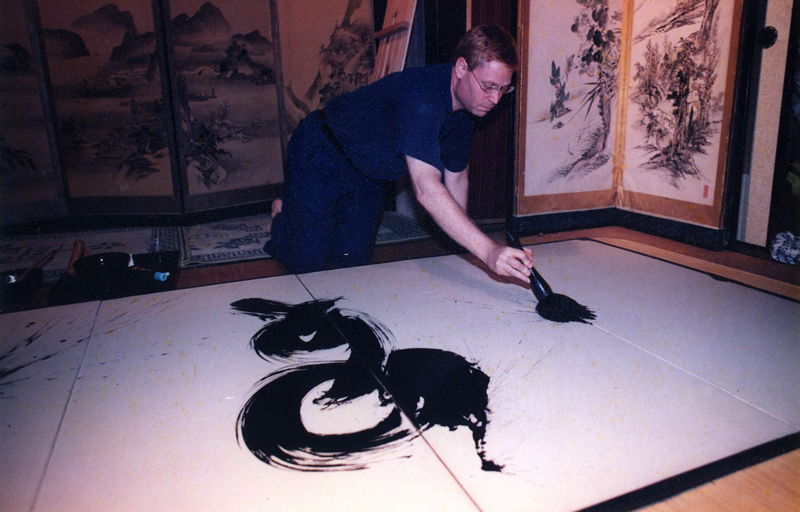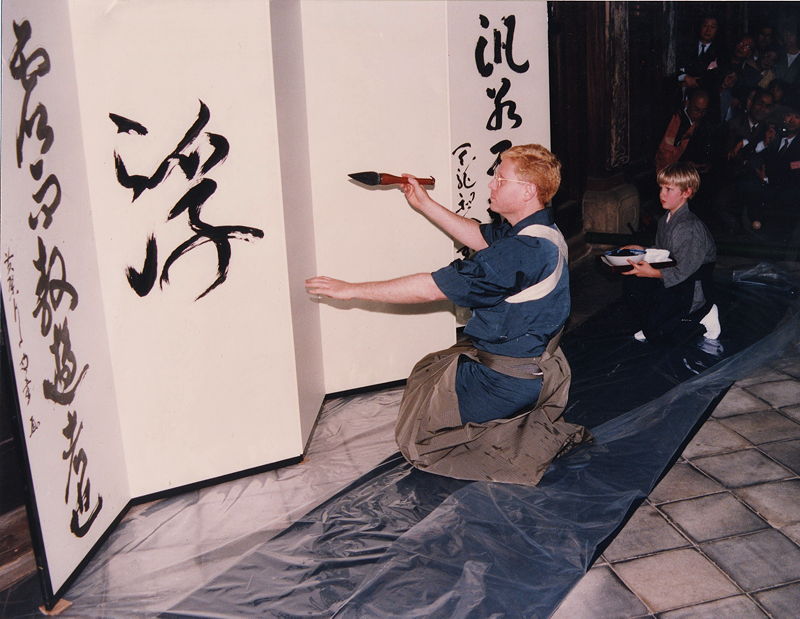Calligraphy
The beginnings
My Background
When I was just nine, I attended a school in Alexandria Virginia that taught Chinese to grade school students. I loved the process of copying the complex strokes of Chinese characters over and over again, and when my family moved to Japan in 1964 when I was twelve, I started practicing calligraphy in earnest. I bought myself a set of brushes and ink, and began practicing. Ever since then calligraphy has been my great love. My art collection concentrates strongly on calligraphy scrolls and screens. Whenever I have some spare time with friends, I get out a bottle of wine, some big brushes, inks of various colors, and begin painting.
Or writing. I’m not sure what is the appropriate word, as sometimes it’s the shape of the character, and other times it’s the meaning that’s uppermost in my mind. After a full night of playing with the brush, and lots of wine, a few special pieces emerge that I save. The rest are rejected and used later for wrapping paper. The results are unpredictable – you can never repair or repeat, each stroke of the brush is instantaneous and has a life of its own. These calligraphies are recent works done in the last two years. Some of them are favorite themes (Wind, Dragon) that I’ve done all my life; and others are new themes, done at the request of friends, such as Dragon, Dawn, Creative.
THe process
My Style
I’ve never had formal training: what I know was learned by copying the art works in my collection. In the process I’ve developed my own style, which is a mix of the two styles ruled Japanese calligraphy for centuries: Literati, and Court. The Literati style is scholarly, focused on a emulation of old writings, poetry, and philosophy.
At the same time, it’s individualistic, free, easy, using broad strokes, and might not mind a bit of roughness, a splatter here or there. This was the form used by Chinese and Japanese literati to
express their philosophy, and is still the main style found today.
In the meantime, the Japanese Court developed a refined calligraphy, known as Wayo. Usually drawn on papers painted delicately in gold, silver, or mica, this style is soft, elegant, and stylized.It’s the graphic equivalent of Noh drama and tea ceremony which grew up at the same time.
Few calligraphers today show the influence of Wayo court style – but it has become a mark of my work. Instead of writing on gold or silver paper, I incorporate the gold and silver into the calligraphy itself, using a painting technique borrowed from traditional Rinpa painting.
I use papers specially ordered to have the right surface for my Rinpa-Wayo Court style; and mix the inks and colors. Then I pick up the brush, and at this point, the Court style fades into the background, and the Literati element comes in: I choose a theme that might have a resonance in history or to me or my friends personally, and then …. it’s literally out of my hands, and the brush moves by itself.
I usually do one character on a single sheet of paper, but sometimes do small formats as well, especially for my annual New Year card, when I attempt to write several hundred to send to friends. The meanings are various. There are some favorite themes: Wind, Love, Flute; and others
that occur at the spur of the moment, or are suggested by friends requesting a particular idea, such as : Compassion, Magic, Lightning, Kirin (fire horse), Dragon, Victory, or even Gloom.
Each piece is the product of a particular night with particular friends – a unique expression of a moment. It’s also an expression of my views on life, the life I’ve had in Japan and East Asia since I was a little boy, and life experienced vicariously through the thoughts and philosophies expressed in calligraphies, paintings, and the traditional arts around me.
Events
Calligraphy Events
One favorite way to do calligraphy is at events, such as parties I’ve held at Mampukuji (1993 Kyoto), or Yushima Confucian Hall (1994 Tokyo), or Soi 16 (2004 Bangkok) combining writing on a folding screen with dance, music, tea ceremony, and input from guests.
I’ve also exhibited calligraphy in various exhibitions over the years, such as Washington Cathedral (1979); and the annual Kyoto Shimbun “Leading Artists of Kyoto Show” (since 1987), etc.



